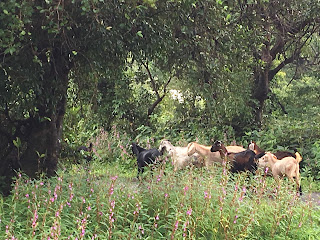Why Gir is the New Jersy Cow of India?- Save Indigenous Cows of India
We love to coin words, most recent being A2 milk, Organic, ZBNF, Biodynamic, Permaculture, Slow food, Hydrophonics , Gluten free etc. etc. enough to get a common man dizzy while making a food decision.
Currently, we are experiencing, what can be termed as the second “White Revolution” (read milk) as opposed to Green Revolution (read chemical farming). In past 3 years, we have had many young 30 some things (invariably an IT professional or a fresh agri graduate looking for business opportunity and a close to nature experience as a perk) visiting our Gau Shala and office. Their knowledge of cow starts with GIR and ends there. GIR has become the undisputed queen of the COW world.
How? Well its just the clever marketing. As usual the non suspecting fell for it.
GIR is beautiful, she has the most amazing set of eyes which will melt anyone. But show me an ugly Cow or an animal. So what is special about this one?
She belonged to the Gir forest in Gujarat. Alright. Since the conversation is limited to COWS, for this article I will use “She” to refer to GIR. They moved in Herds, grazed in open, ate grasses, herbs, medicinal plants, wild vegetables, wild flowers, basically whatever appealed to their taste buds. Not to forget they got a lot of exercise and sunshine. They looked after their young ones and the old, like any other community with no one to fuss around. As humans we need to accept, animals are capable of delivering and taking care of their off spring, and are perfect machines just like humans. She had the best habitat and no pressure to perform, she produced the milk for her babies. Some where down the line she got domesticated and then the COW became Gaumata, Kamdhenu. Humans claimed right over her milk besides her Calf.
Above story applies to all the Indigenous reeds of cows in India.
Somewhere parallel, many children were getting sick and were detected with Lactose intolerance (a new term then) and that baffled scientists. Sugar imbalance, declined eye site, declined attention span and many such symptoms lead to the root cause of then popular cow milk across the world of Jersy and Holsteins. So the imported cow which did not belong to the original stock became A1 and that of Desi/indigenous cow became A2. I wouldn’t want to get into scientific details as its been written and spoken widely all over.
Since when did the Desi/Indigenous Indian cow became synonymous with Gir? Point to ponder and we should look for that clever business model, who started this trend? Later some clever people from Rajasthan and Punjab -Harayana tried with Tharparkar and Sahiwal but could not match the finesse of the Gir business model.
The first moral of the story is there are around 43 varieties of these Desi cows (erstwhile belonged to wild grazing herds in different parts of the country). Whose milk when lab tested classifies as A2 milk.
Second, if you stuff them in a tiny ill lit cow shed, tie them up, feed them in confined space the same measured quantity of food day in day out, do not exercise them, not allow playtime with their mates and bonding with the young ones, rob the socializing from their lives and then in order to keep them lactating for long durations inject them with steroids soon her A2 milk will turn into A1.
People fine, Desi cow milk is fit for human consumption but let us not turn it into another DIARY industry. When we start exploiting the animal, keep it at our mercy, we are rearing an unhappy soul , sad life. Empathy is foundation of Sustainability.
Next time you want Cow milk fit for human consumption, ask for Desi Cow milk. Let the other local cows thrive. Save the Gir from this pressure and let the cow enjoy her life too.
Its time, we read beyond lines. Observe and use our conventional wisdom and local wisdom before we make any decision.
Btw, the other beautiful cows of India:
Amritmahal - Karnataka
Bachaur - Bihar
Bargur - Tamilnadu
Dangi - Maharashtra and Madhya Pradesh
Deoni - Maharashtra and Karnataka
Gaolao - Maharashtra and Madhya Pradesh
Gir - Gujrat
Hallikar - Karnataka
Hariana - Haryana, Uttar Pradesh and Rajasthan
Kangayam - Tamilnadu
Kankrej - Gujarat and Rajasthan
Kenkatha - Uttar Pradesh and Madhya Pradesh
Kherigarh - Uttar Pradesh
Khillar - Maharashtra and Karnataka
Krishna Valley - Karnataka
Malvi - Madhya Pradesh
Mewati - Rajasthan, Haryana and Uttar Pradesh
Nagori - Rajasthan
Nimari - Madhya Pradesh
Ongole - Andhra Pradesh
Ponwar - Uttar Pradesh
Punganur - Andhra Pradesh
Rathi - Rajasthan
Red Kandhari - Maharashtra
Red Sindhi - On organized farms only
Sahiwal - Punjab and Rajasthan
Siri - Sikkim and West Bengal
Tharparkar - Rajasthan
Umblachery - Tamilnadu
Vechur - Kerala
Motu - Orissa,Chhattisgarh and Andhra Pradesh
Ghumusari - Orissa
Binjharpuri - Orissa
Khariar - Orissa
Pulikulam - Tamilnadu
Kosali - Chhattisgarh
Malnad Gidda - Karnataka
Belahi - Haryana and Chandigarh
Gangatiri - Uttar Pradesh and Bihar
Badri - Uttarakhand
Lakhimi - Assam
Ladakhi - Jammu and Kashmir
Konkan Kapila - Maharashtra and Goa




Comments
Post a Comment